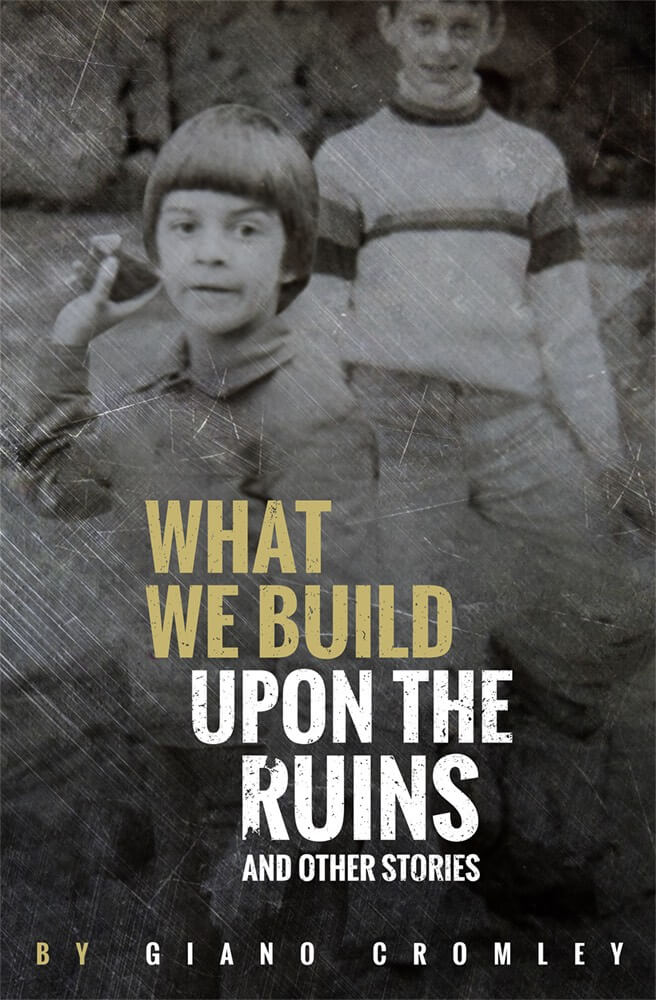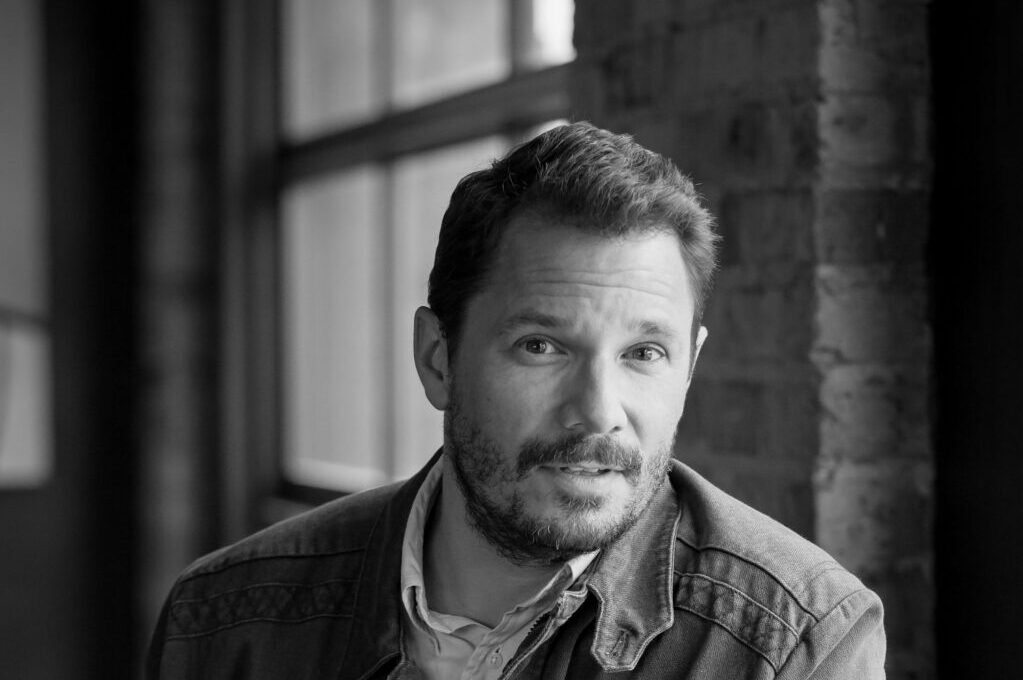
In the 1980’s, when Raymond Carver’s short fiction began reaching a wide audience, the phrase “dirty realism” was often used to describe Carver’s tales of working class people struggling through their unglamorous but emotionally fraught lives. While the phrase has fallen out of vogue in recent decades, it is a useful reference point for the stories in What We Build upon the Ruins (Tortoise Books.) Cromley’s fiction recalls Carver and writers like Tobias Wolff and Stuart Dybek; his characters navigate a complicated and often harsh world, but do so with resilience and a willingness to put their hearts at risk. Purchase a copy here.
Cromley shared his thoughts with Cease, Cows.
Chuck Augello: Three of the stories in What We Build upon the Ruins are clearly linked, yet the others seem to share some of those stories’ underlying themes. How would you describe the book’s thematic concerns?
Giano Cromley: I can’t honestly say I set out to put this collection together with an overriding thematic concern. The oldest story in this collection I wrote the first draft of back in 1997. So if there is a connection that ties them all together it’s more by happenstance, and would represent ideas that have been percolating in my subconscious for the better part of two decades. Putting them all together in one place was a good way for me to look at them through that lens. I’d say the stories are all concerned with the idea of building or rebuilding — people putting the fractured pieces of their lives back together and finding a way to keep living. Some of the characters aren’t successful at it and others aren’t aware of the flaws that caused their problems in the first place, but they’re all still trying. That’s an important thing for me. And I hope it shows through in these stories.
CA: The title story, “Human Remains,” and “The Physics of Floating” concern a family on a canoe-building trip in the wake of a family tragedy. Were they conceived as three distinct stories or a single longer narrative? How did you come to write these?
GC: It started on a trip to Michigan’s Upper Peninsula and a visit to the Museum of Ojibwa Culture. They had a DVD playing on repeat of a tribal elder building a birchbark canoe, and I was mesmerized. In that first moment, I knew I wanted to tell a story about building one of those. From there, the story started with a voice, which turned out to be the young narrator, Jack. As the other story elements started to come together, I realized it was going to be too short for a novel, but too long for a regular short story. So I started thinking of a collection I used to love called The Watch, by Rick Bass. In it, the first story is a memorable piece that feels relatively self-contained. Then, about halfway through the collection, the characters from that first story come back for a new story. At the time I first read it, it felt like getting a visit from some old friends. Then I started to think maybe I could do that with my canoe story. That freed me up to approach it slightly differently than if it had been a single conventional story. I was able to focus on different characters in each one and explore different themes as well. So I really did write it as three separate stories, though they clearly follow a very linear narrative structure.
CA: The canoe-building stories are narrated by twelve-year-old Jack. When writing a story, how do you decide the point of view character?
GC: Whenever I write a story in first person (like the canoe stories), it typically starts with a voice I hear in my head — maybe a single line of dialogue or an odd turn of phrase. From there, I just take the plunge and start writing. I’d liken it to improv. I don’t know where I’m going and I don’t know any details, but if I just follow that voice the answers will come to me along the way. For stories that I write in third person, it’s usually a single image that strikes me. It could be a mood-setting image or a larger thematic image. Then I’ll start to construct the story around it.
CA: The natural world plays a prominent role in many of the stories. What do you find attractive about nature as a setting for fiction?
GC: I grew up in Montana, and I like to tell people I’ve got the mountains in my blood. The natural world is where I’m most comfortable, where I can feel my batteries recharging. I think in order to be a writer, you have to be an observer and an intuiter. Whenever I find myself in nature, I’m really able to flex those brain muscles. So I guess using it in my writing feels like a natural extension of that.
CA: In the story “Ling,” two high-school friends, about to take different paths after graduation, head out on a fishing trip. The story is set during the days leading up to the Iraq War, when it was conceivable that the rush to war might be stopped. How does that particular historical moment influence the story, and the lives of the two friends, Sammy and Chuck?
GC: I think historical inflection points are always useful settings in fiction. They tend to put the characters’ own states of precariousness into sharper relief. When I first wrote “Ling,” it was set during the run-up to the first Iraq war. For the collection, I edited it to imply that they’re on the cusp of the second Iraq war. I was a senior in high school during the first one and I remember the weird uncertainty and anxiety that pervaded our lives during that time. Younger people I knew, during the run-up to the second Iraq war, had a similar feeling as well. In my mind, that made for a good backdrop for these boys who are approaching their own personal historical inflection points.
CA: In “Those Who Trespass,” a community college teacher develops an attachment to a girl he’s never met after finding her backpack in the restroom. Tell us about Vincent, the teacher. Why is he drawn into this girl’s life?
GC: Vincent is drawn into Latricsa’s life because something is missing in his own life. Namely any sort of authenticity. His home life is cold and fake. He’s about to become a father and isn’t happy about it. He manages to convince himself that he’s doing something altruistic by returning a girl’s missing backpack. But in reality, he’s following this course for purely selfish reasons, as a way to seek out what he’s missing. In a post-colonial literature class you might call this a journey of insubstantialization — basically a way to be a kind of tourist in someone else’s world with the full knowledge that whenever he wants, he can pick up and go home. Vincent is someone who’s a doing “good” thing for bad reasons. And that usually doesn’t work out very well.
CA: Who are some of the writers you admire? Are there any specific short stories that made you put down the book and say “Wow!” after you finished reading it?
GC: There are so many good short stories and short story writers out there that it’s painful to pick out just a few. If forced, I’d say some of the biggest influences on my short story writing would be Joy Williams, Paul Bowles, Tobias Wolff, and Sherman Alexie. I’d say their stories share a similar aesthetic feel to mine. Probably one of my all-time favorite short stories is “Paper Lantern” by Stuart Dybek. Now that’s a story that haunts me, compelling me to come back and seek it out repeatedly. And whenever I get done with it, I need to hold my head in my hand to pull myself together afterwards. Yet I don’t think I’d ever try to write a story like it. Every writer has a certain set of magic tricks at his or her disposal; it’s best to find out what yours are and don’t try to use someone else’s.
CA: Finally, there’s no shortage of ways to spend one’s time. Why do you choose to write?
GC: Writing is something I’ve always done, and I imagine it’s something I’ll always do. I love the feeling of words shifting around in my head, shuffling them until the right sentence comes together. I feel a cosmic ping when that happens. To me, writing is the sun I orbit around. There may be stretches when I’m farther away and don’t feel the pull so strongly, but inevitably, its grip will exert itself and draw me back in.
–
Chuck Augello (Contributing Editor) lives in New Jersey with his wife, dog, two cats, and several cows that refuse to cease. His work has appeared in One Story, Juked, Hobart, Smokelong Quarterly, and other fine places. He publishes The Daily Vonnegut and contributes interviews to The Review Review. He’s currently at work on a novel.

